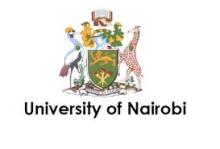Resource information
Livestock is a crucial source of financial capital for the rural poor. The arid and semi arid lands
are home to nearly 70% of the national herd with an estimated value of Kenya shillings 70
billion. For many, it is the only form of savings available. Therefore, its efficient production and
marketing is essential for sustaining pastoral livelihoods. The existing Garissa livestock market
in Central Division of Garissa District covers a total area of approximately 10 acres. It provides a
range of employment and income-earning opportunities. Despite its importance, its spatial size is
small compared to the large number of livestock that are traded through it thus leading to a spill
over effect to the neighbouroods and causing land use conficts.
This study determined the major land use conflicts of the existing Garissa livestock market,
estimated the population of livestock traded at the market by type and determined the appropriate
market size, design and location to optimize benefits and minimize negative impacts. It also
determined the social, economic and environmental impacts to its neighbourhoods and Garissa
town as a whole and has proposed intervention measures to ensure efficient marketing of
livestock and reduction of land use conflicts.
The first phase of the study involved literature review where information on livestock market
and livestock in general was reviewed. The second phase involved collection of secondary data
on animal diseases, economic, social and environmental impacts of the market and land uses.
The third phase involved collection of primary data where data was collected as it existed with
the source. After data collection, it was edited and analysed. Finally, a final report in the form of
maps, figures, photographs, tables and charts was produced.
The findings show that there is a permanent road that passes through the livestock market that
links the neighbourhoods to Garissa town. This road is mainly used by pedestrians and vehicular
traffic and is the main cause of accidents within the livestock market. The main livestock traded
in Garissa livestock market are cattle, goats, sheep, camels and donkeys. They have different
selling prices. The size of the market is inadequate and is not well designed and thus lacks most
of the facilities that are required by a livestock market. The market is the major source of
employment and income. It employs thousands of people ranging from livestock herders to
traders. Some government departments from Garissa County collect revenue from the market.
The main social impact is that it has improved on the diversity of the people. Intermarriages
between different communities and gaining knowledge from one another are also important
social impacts of the market. Negative social impacts include, cultural degradation and
insecurity. Some of the negative environmental impacts include, air and noise pollution and
spread of zoonotic diseases.
The main recommendations of the study include; Improvement on market facilities, closure of
the market road, provision of alternative parking areas outside the market, establishment of
livestock market management board, fencing and relocation of the existing market. Further
research can be carried out on modern ranching practices that can enhance livestock production
in Garissa county. Further research can also be carried out on the improvement of the road
infrastructure in Garissa County.


